.
7.02.2013
Far beyond the orbits of Neptune and Pluto, where the sun is a pinprick of light not much brighter than other stars, a vast swarm of icy bodies circles the solar system. Astronomers call it the "Oort Cloud," and it is the source of some of history's finest comets.
One of them could be heading our way now.
.

Comet Pan-STARRS was discovered by the Panoramic Survey Telescope & Rapid Response System atop the Haleakala volcano in Hawaii. Astronomers use the massive 1.8 meter telescope to scan the heavens for Earth-approaching objects, both asteroids and comets, that might pose a danger to our planet. In June 2011 a comet appeared, and it was named "Pan-STARRS" after the acronym for the telescope.
In early March, the comet will pass about 100 million miles from Earth as it briefly dips inside the orbit of Mercury. Most experts expect it to become a naked-eye object about as bright as the stars of the Big Dipper.
"But" says Karl Battams of the Naval Research Lab, "prepare to be surprised. A new comet from the Oort Cloud is always an unknown quantity equally capable of spectacular displays or dismal failures."
The Oort cloud is named after the 20th-century Dutch astronomer Jan Oort, who argued that such a cloud must exist to account for all the “fresh” comets that fall through the inner solar system. Unaltered by warmth and sunlight, the distant comets of the Oort cloud are like time capsules, harboring frozen gases and primitive, dusty material drawn from the original solar nebula 4.5 billion years ago. When these comets occasionally fall toward the sun, they bring their virgin ices with them.
Because this is Comet Pan-STARRS first visit, it has never been tested by the fierce heat and gravitational pull of the sun. "Almost anything could happen," says Battams. On one hand, the comet could fall apart--a fizzling disappointment. On the other hand, fresh veins of frozen material could open up to spew garish jets of gas and dust into the night sky.
"Because of its small distance from the sun, Pan-STARRS should be very active, producing a lot of dust and therefore a nice dust tail," predicts Matthew Knight of the Lowell Observatory.
"However," he cautions, "it could still be difficult to see. From our point of view on Earth, the comet will be very close to the sun. This means that it is only observable in twilight when the sky is not fully dark."
The best dates to look may be March 12th and 13th when Pan-STARRS emerges in the western sunset sky not far from the crescent Moon. A comet and the Moon, together, framed by twilight-blue is a rare sight. "My guess is that the primary feature visible to the naked eye will be the gaseous coma around the head of the comet,” says Knight. “The comet's tail will probably require binoculars or a small telescope."
Two other key dates are March 5th when the comet comes closest to Earth (about 100 million miles away) and March 10th, when the comet comes closest to the sun. The dose of solar heating it receives just inside the orbit of Mercury could be just what the comet needs to push it into the realm of naked-eye visibility.
Comet Pan-STARRS should not be confused with another, even better comet coming later this year. In Nov. 2013, Comet ISON could shine as brightly as a full Moon in broad daylight when it passes through the atmosphere of the sun.
"Two bright comets in one year is a rare treat," says Battams. "This could be good."
.
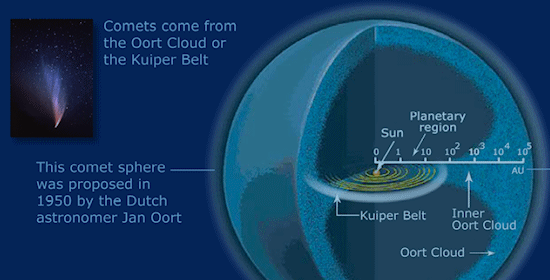
.
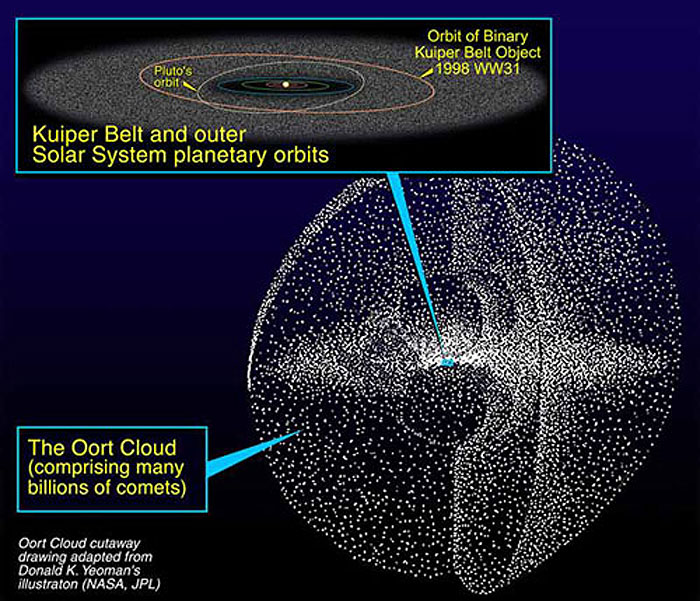
.
Quelle: NASA
-

.
Update: 19.02.2013
.
Comet Pan-STARRS (C/2011 L4), widely expected to become a naked-eye object in early March, is now closer to the sun than Venus. Solar heating is vaporizing the comet's icy core and creating a wide, fan-shaped tail visible through binoculars in the southern hemisphere. Ignacio Diaz Bobillo sends this picture from Buenos Aires, Argentina
.
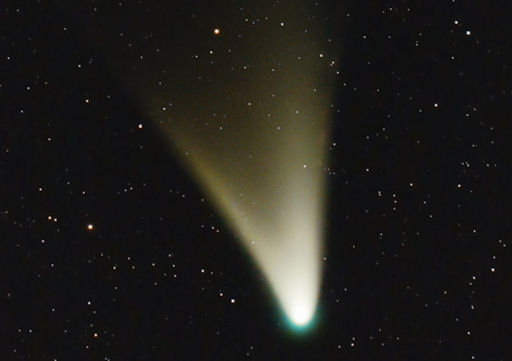
.
Update: 20.02.2013
.

.
Update: 22.02.2013
.
Comet Will Be Visible from Hawaii in March
Honolulu, Hawaii—Comet PANSTARRS C/2011 L4, discovered by the Pan-STARRS 1 telescope on Haleakala in June 2011, is expected to become visible to the naked eye in Hawaii in March.
The Institute for Astronomy of the University of Hawaii at Manoa will hold a free comet-viewing event from 6:30 to 7:30 p.m. on Tuesday, March 12 on Magic Island’s picnic area 36, which is near the beach at the ewa end. Stargazing will follow comet viewing.
The comet is currently visible in the Southern Hemisphere, but is too far south to be seen here.
From about March 7, it will appear above the horizon in Hawaii. To see it, you will need an unobstructed, cloudless view of the western horizon. It is best to pick a dark spot, away from streetlights.
Look in the direction of the sunset just after the sun has gone down. The comet will be just above the horizon. The chart below shows the position of the comet in the western sky at 7:00 p.m. throughout the month of March.

The twilight sky will make the comet much harder to see than if it were high up in a dark sky, and moonlight will interfere with viewing the comet after March 13.
To see the comet’s tails, you may need a pair of binoculars.
Although the brightness of comets is notoriously difficult to predict ahead of time, scientists expect this comet will have a brightness similar to that of the stars in the bowl of the Big Dipper or Orion’s belt (magnitude 2 to 3).
March 13 may be the best time to take an interesting picture of the comet because on that evening, it will appear just below the thin crescent moon.
By the end of March, the comet will no longer be visible in the evening sky, but if you get up early, you may be able to see it in the eastern sky just before sunrise. However, by then the comet will be farther from both the sun and Earth, and will therefore be fainter.
Comets are balls of ice and dust. As they approach the sun, they heat up, and the ice begins to sublime—to change from ice into a gas. When that happens, they develop a coma, a large envelope of gas and dust that surrounds the solid nucleus, and two tails, a dust tail and an ion tail that consists of gas molecules ionized by sunlight. Each of these tails may be over a million miles long. It is because of the coma and tails that they become visible to the naked eye, sometimes spectacularly so.
Some comets, including Comet PANSTARRS, follow an orbit that begins in the very outer reaches of the solar system. As they pass by the planets, they receive a gravitational “kick” that propels them out of the solar system. Their sole visits to the inner solar system are therefore our only chance to see them.
Others, like Halley’s comet, have elliptical orbits, and return to the inner solar system again and again, although their orbits are sometimes so large that it takes hundreds or thousands of years for them to return.
The Pan-STARRS Project is being led by the University of Hawaii Institute for Astronomy, and exploits the unique combination of superb observing sites and technical and scientific expertise available in Hawaii. Funding for the development of the observing system has been provided by the United States Air Force Research Laboratory. The PS1 Surveys have been made possible through contributions by the Institute for Astronomy, the University of Hawaii, the Pan-STARRS Project Office, the Max-Planck Society and its participating institutes, the Max Planck Institute for Astronomy, Heidelberg and the Max Planck Institute for Extraterrestrial Physics, Garching, The Johns Hopkins University, Durham University, the University of Edinburgh, the Queen's University Belfast, the Harvard-Smithsonian Center for Astrophysics, the Las Cumbres Observatory Global Telescope Network, Incorporated, the National Central University of Taiwan, and the National Aeronautics and Space Administration under Grant No. NNX08AR22G issued through the Planetary Science Division of the NASA Science Mission Directorate. Any opinions, findings, and conclusions or recommendations expressed in this article are those of the author(s), and do not necessarily reflect the views of the National Aeronautics and Space Administration.
Quelle:Institute for Astronomy at the University of Hawaii at Manoa
.

TWO COMETS AND THE SOUTHERN LIGHTS: Two comets are now visible in the skies of the southern hemisphere: "Comet Lemmon and Comet PanSTARRS got close enough together on the morning of Feb. 17th to fit into single image with a 35mm lens," reports Alex Cherney of Flinders, Victoria, Australia.
"Both comets were faint but visible to the naked eye, C/2011 L4 (PanSTARRS) slightly brighter than C/2012 F6 (Lemmon)," says Cherney. "I would guestimate the visual magnitude of Comet Lemmon at +5.5 and PanSTARRS at +5." Also visible in Cherney's images are the Small Magellanic Cloud and the 47 Tuc globular star cluster.
.

.

.
Update: 25.02.2013
Our long-anticipated highlight for March is likely to be the emergence of Comet PANSTARRS in our evening twilight. Officially called Comet 2011 L4 (PANSTARRS) it reaches perihelion, its closest to the Sun (45 million km), on the 10th.
Our first sight of it may come two days later when it stands only 6° high in the W and the same distance to the left of the one-day-old Moon forty minutes after sunset. We will probably need binoculars, and certainly a clear horizon, to glimpse either object in the bright twilight. A day later the comet is 7° high and 7° below-right of the Moon. Updated predictions have it near the third magnitude at that time, with a dust tail stretching several degrees away to its upper-left.
The following days see it climb to pass 6° to the left of Algenib, the lower-left star of the Square of Pegasus, on the 16th and 7° left of Alpheratz, top-left in the Square, on the 23rd. By then it may be fainter than the fourth mag and its dust tail may be close to vertical. Expect more details here in Starwatch on the 11th.
With Mercury, Venus and Mars hidden in the Sun's glare from our latitudes this month, Jupiter, conspicuous high in our S sky at nightfall, is one of only two naked-eye planets on show. The other is Saturn which rises in the ESE minutes after our map times and passes some 24° high in the S five hours later. Saturn brightens from mag 0.4 to 0.3 in March, shows an 18 arcsec disc with rings 41 arcsec wide at mid-month and is passed by the Moon on the 2nd and 29th.
Jupiter dims from mag -2.3 to -2.1 as it slides eastwards above Aldebaran and the Hyades cluster in Taurus. The planet's cloud-banded disc appears 37 arcsec wide when the planet lies near the Moon on the 17th.
March diary
2nd 15h Moon 3˚ S of Saturn
4th 13h Mercury in inferior conjunction; 22h Last quarter
10th 04h Comet PANSTARRS at perihelion
11th 20h New moon
18th 01h Moon 1.5˚ S of Jupiter
19th 17h First quarter
20th 11:02 Vernal equinox
24th 18h Jupiter 5˚N of Aldebaran
27th 09h Full moon
28th 17h Venus in superior conjunction
29th 01h Uranus in conjunction with Sun; 20h Moon 3˚ S of Saturn
31st 01h GMT = 02h BST start of British Summer Time
The Guardian
.
Update: 28.02.2013
.

.

.
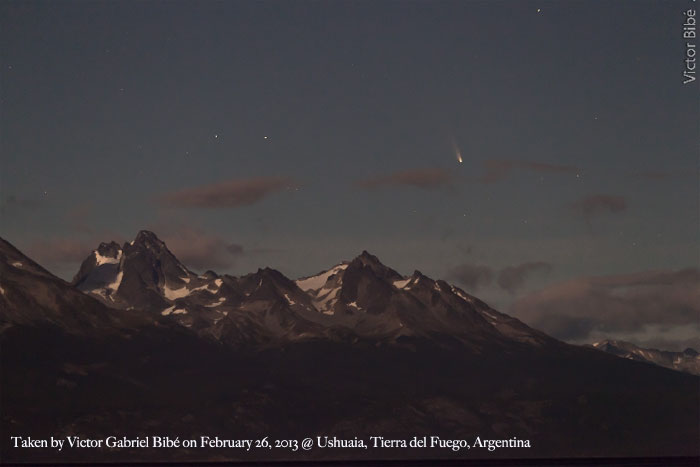
.
Update: 3.03.2013

Comet Pan-STARRS (C/2011 L4) is now inside the orbit of Mercury, brightening as it plunges toward the sun. Observers in the southern hemisphere report say they can see Pan-STARRS with the unaided eye in the evening sunset sky. Carl Gruber photographed the comet on March 2nd over the city lights of Melbourne, Australia:
-
Update: 5.03.2013
Northern Hemisphere's turn
The comet should begin to finally become visible to Northern Hemisphere skywatchers on Thursday (March 7), weather permitting, when it will rise very low near the west-southwest horizon about a half hour after sunset.
Next Tuesday (March 12), the comet will stand almost directly above the western horizon, less than 5 degrees to the left of a very narrow crescent moon. The comet will continue to slowly get higher and shift slowly toward the west-northwest part of the sky during the middle and later part of March, also becoming gradually dimmer as it pulls away from both the sun and the Earth.
Any tail that may be present should appear to be pointed straight up and tipped to the left through mid-March, then for the remainder of the month be tipped a bit more to the right. Update:
5.03.2013 / 22.30 MEZ
A German travel agency is selling tickets for a flight to give 88 astronomy buffs a close-up view of one of two rare comets expected to pass Earth this year.
Eclipse Travel, based in Bonn, has joined charter agency Air Partner and airline Air Berlin to organize flight AB1000 on March 16 as comet Pan-STARRS passes through the solar system, 100 million miles from Earth.
The last comet to dazzle Earth's night-time skies was Comet Hale-Bopp, which visited in 1997. Comet 17P/Holmes made a brief appearance in 2007.
The Boeing 737-700 flight will zig-zag at 11,000 meters (36,089 feet) altitude for the viewing with an Air Berlin spokesman saying only 88 of 144 seats on board filled to ensure all travelers are close to a window.
"If the weather is very good and the air is clear you can certainly see the comet from Earth," Air Berlin's Karsten von dem Hagen, Teamleader Sales Ad Hoc Flights, said in an e-mail to Reuters on Tuesday.
"But at an altitude of 11,000 meters you are most likely above the clouds. The air there is thinner, clearer and cleaner, which enables better observation of the comet."
An astronomy expert will be on board to explain the comet that NASA described as a new comet that should be visible by the naked eye and about as bright as the stars of the Big Dipper as it passes through the solar system this month.
NASA scientists said the comet could send an amazing tail of gas and dust into the night sky but the cosmic show could be less than dazzling if the comet falls apart under the heat and gravitational pull of its plunge toward the sun.
The comet Pan-STARRS, discovered by astronomers in Hawaii in 2011, is the first of two comets expected to pass Earth this year.
The second is ISON, which is forecast to be one of the brightest comets ever seen and could even outshine the moon when it flies by in late November.
Eclipse Travel is selling tickets for the two-hour flight for between $470 and $663, according to its website.
Update: 8.03.2013
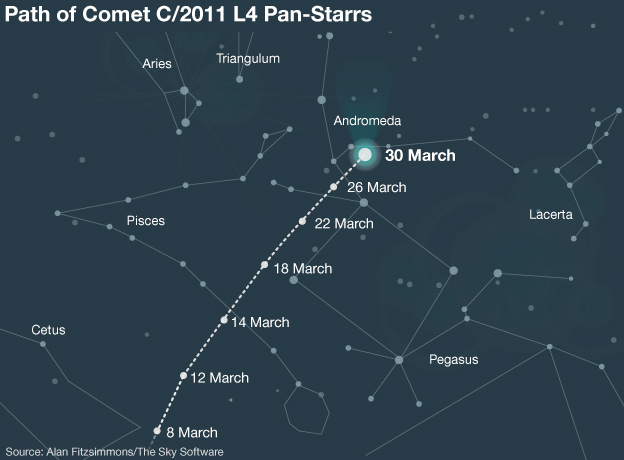
The 12 and 13 March could provide the best viewing opportunity. At this time, it will move further from the Sun, but should be easier to spot in the night sky, providing it is a clear night.
"After sunset, scan the horizon roughly in the western direction. On the 12 and 13 March, there is a nice association with the thin crescent Moon," advised Prof Bailey.
"You can use the Moon as a guide, and search just down or to the left of the Moon. Through binoculars you should be able to see the head of the comet and certainly the two types of the tail."
He added: "I would always advise people to hunt for comets with binoculars, but if you have found it with binoculars, have a good hunt around and see if you can see it with the naked eye. That's quite a challenge - but it is a wonderful thing to have seen."
After this, the comet will begin to appear later and higher up in the night sky. And then, as April draws near, it will vanish back into the depths of space where it can only be seen with large telescopes.
If the weather proves poor during this period, astronomers could be offered another chance for a celestial delight at the end of the year when comet Ison should grace our skies.
Flying four times closer to the Sun than Pan-starrs, it could prove even brighter. But there is also a chance that it could break up.
.
Update: 11.03.2013
Blick auf Kometen, in der Hoffnung ihn bald auch sehen zu können, wenn Schnee-Wolken vorbei sind und klarer Himmel solchen Anblick gewährt:
.

Comet C/2011 L4 PANSTARRS as seen from Mount Dale, Western Australia. The lights on the distant horizon are from the city of Armadale, which is southeast of Perth. Image credit: Astronomy Education Services/Gingin Observatory
.
STEREO-B SEES COMET PAN-STARRS: On March 10th, Comet Pan-STARRS passed by the sun just inside the orbit of Mercury. The close encounter brought it into the field of view of NASA's STEREO-B spacecraft. The sun, Earth, and comet are labeled in this low-resolution beacon image from STEREO-B's Heliospheric Imager:
.

.
Update: 12.03.2013
Astrophotographer Adam Block of the Mt. Lemmon SkyCenter took this photo of Comet Pan-STARRS (C/2011 L4) over Tucson, AZ, on March 10, 2013.
CREDIT: Adam Block/Mount Lemmon SkyCenter/University of Arizona
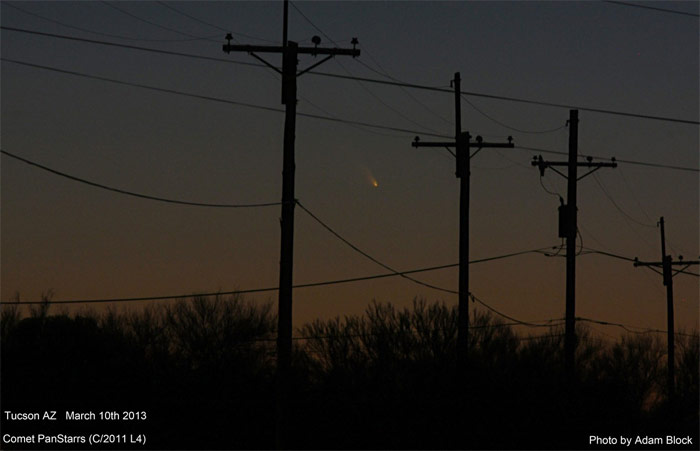
.
Update: 13.03.2013
.
Last night, March 12th, a rare meeting occured in the sunset sky. Comet Pan-STARRS (C/2011 L4) was only a few degrees away from the exquisitely-slender crescent Moon. Brian Klimowski sends this picture from the countryside near Flagstaff, Arizona:
.

.
In der Hoffnung, bald auch hier nach den Schneewolken zu sehen...
.
Update:15.03.2013
.

.
Update: 16.03.2013
.
Frams von NASA-Video


Wie wir schon am 5.03.2013 / 22.30 MEZ berichteten:
A German travel agency is selling tickets for a flight to give 88 astronomy buffs a close-up view of one of two rare comets expected to pass Earth this year.
Eclipse Travel, based in Bonn, has joined charter agency Air Partner and airline Air Berlin to organize flight AB1000 on March 16 as comet Pan-STARRS passes through the solar system, 100 million miles from Earth.
The last comet to dazzle Earth's night-time skies was Comet Hale-Bopp, which visited in 1997. Comet 17P/Holmes made a brief appearance in 2007.
The Boeing 737-700 flight will zig-zag at 11,000 meters (36,089 feet) altitude for the viewing with an Air Berlin spokesman saying only 88 of 144 seats on board filled to ensure all travelers are close to a window.
"If the weather is very good and the air is clear you can certainly see the comet from Earth," Air Berlin's Karsten von dem Hagen, Teamleader Sales Ad Hoc Flights, said in an e-mail to Reuters on Tuesday.
"But at an altitude of 11,000 meters you are most likely above the clouds. The air there is thinner, clearer and cleaner, which enables better observation of the comet."
.
Drücken wir unserem bekannten DANIEL FISCHER die Daumen, welcher heuteabend diesen Flug mitmacht und sicherlich einen perfekten Sitzplatz in der ersten Reihe hat da Oben. Im Gegensatz zu hier Unten, bei dichter Bewölkung!
.
Drücken wir unserem bekannten DANIEL FISCHER die Daumen, welcher heuteabend diesen Flug mitmacht und sicherlich einen perfekten Sitzplatz in der ersten Reihe hat da Oben. Im Gegensatz zu hier Unten, bei dichter Bewölkung!
.
Update: 17.03.2013
.
Flug zu Pan-STARRS per airberlin:
.

.
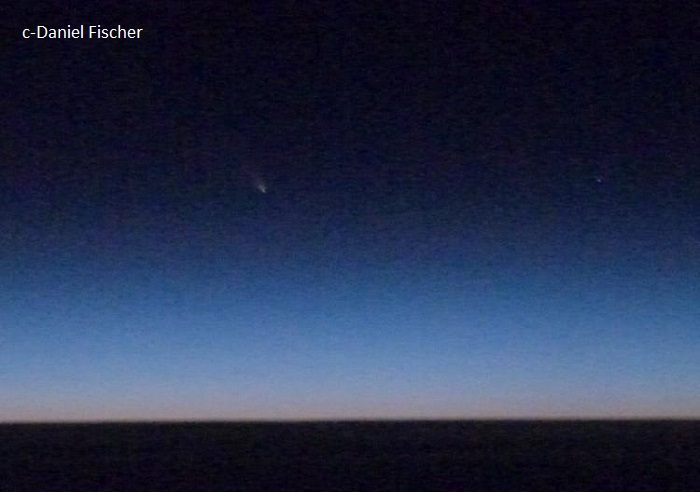
Freier Blick auf Pan-STARRS aus airberlin-JET
:
Das Medien-Interesse war enorm an wohl ersten öffentlichen Kometen-Beobachtungs-Flug seit Halley 1986, und so wuselten gestern Nachmittag bereits beim Check-In im Flughafen Köln-Bonn ein halbes Dutzend Kamera- und Tonleute zweier TV-Teams um den Organisator Stefan Krause (u.) von Eclipse-Reisen und die rund 55 Passagiere – darunter viele Veteranen exotischer Astro-Reisen, mit edlen Kameras und sogar Stativen bepackt.
.
Mehr darüber hier: http://skyweek.wordpress.com/2013/03/17/panstarrs-naher-per-flugzeug-so-wars-da-oben/
.
Update: 20.03.2013
.

.
Update: 5.04.2013
.
PanStarrs nahe Andromeda über Dänemark aufgenommen:
.
NetOp now stands comet Pan-Starrs pretty close galaxy Andromeda on nattehimlen. Look here, what you see and how you see it.
In these dage you mulighed that Oplev one smuk cosmic duo. Pretty close hinanden on aftenhimlen's comet Pan-Starrs and the Andromeda galaxy.
Leisure Photographer Jesper Green vovede sig ud in the cold, clear evening air near Silkeborg Wednesday 3 april and rail mated on fresh gerning.
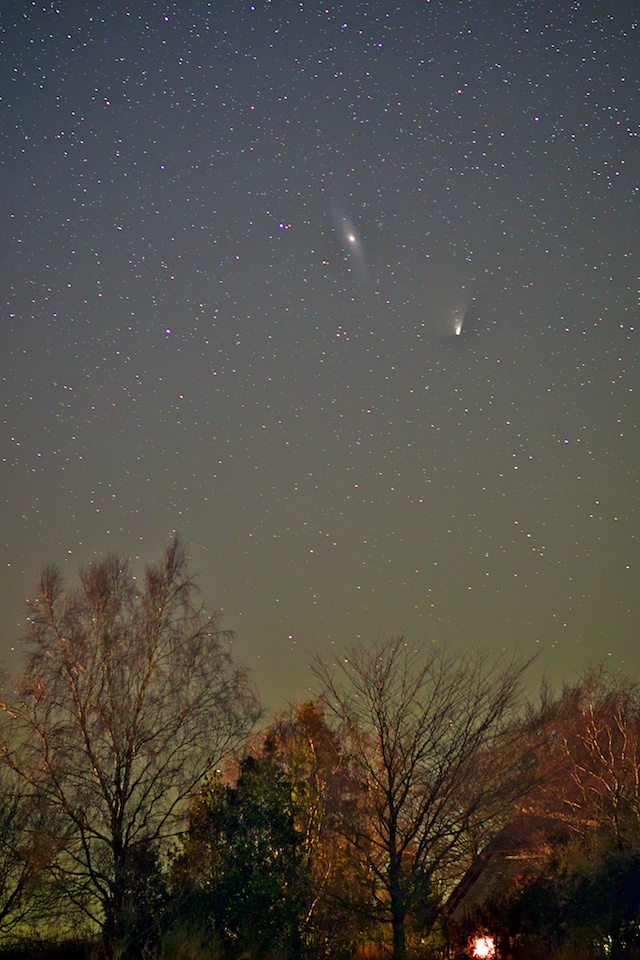
Andromeda and Pan-Starrs on the evening of 3rd April 2013. It is the comet on the right. Photo Jesper Green.
"This evening, both celestial objects visible with binoculars in a northwesterly direction after 22 o'clock," he writes.
"This evening, both celestial objects visible with binoculars in a northwesterly direction after 22 o'clock," he writes.
.

Quelle:Mogens Zachariasen LAF
Lollands Astronomiske Forening
Lollands Astronomiske Forening
.
6991 Views
